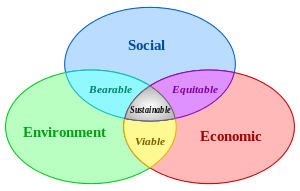Coupled human–environment system
A coupled human–environment system (known also as a coupled human and natural system, or CHANS) is an integrated scientific framework for studying the interface and reciprocal interactions that link human (e.g., economic, social) to natural (e.g., hydrologic, atmospheric, biological) sub-systems of the planet.[1][2] The phrase "coupled human–environment systems" appears in the earlier literature (dating back to 1999) noting that social and natural systems are inseparable.[3][4] "In 2007 a formal standing program in Dynamics of Coupled Natural and Human Systems was created by the U.S. National Science Foundation."[2]:218 A symposium on "Complexity in Human–Nature Interactions across Landscapes" was held at a 2009 meeting of the U.S. Regional Association of the International Association for Landscape Ecology in Snowbird, Utah.[2] Research into CHANS is increasing in frequency in scientific literature concerning the sustainability and conservation of ecosystems and society.[5]
Research into CHANS builds on the disciplines of human ecology, ecological anthropology, environmental geography, economics, and other eco-bio-geo-physical fields. Moving beyond some of the traditional research methods in the social and natural sciences, CHANS tackles broader investigations into the complex nature of reciprocating interactions and feedbacks between humans on the environment and the effect of the environment on humans. Research into CHANS emulates the more traditional research programs that tended to separate the social from the ecological sciences.[6][7]
Outline
In 2007 the National Science Foundation prioritized to fund research on “coupled natural and human systems,” within its program called Biocomplexity in the Environment. This was later broken up into more specific subgroups, such as
- Dynamics of Coupled Natural and Human Systems[8]
- Materials Use: Science, Engineering, and Society (Deadline Date: February 7, 2007)
- Environmental Genomics
Bibliography
- W.C. Clark, B. L. Turner, R. W. Kates, J. Richards, J. T. Mathews, and W. Meyer, eds. The Earth as Transformed by Human Action. (Cambridge, UK: Cambridge University Press, 1990).
- "Illustrating the coupled human–environment system for vulnerability analysis: three case studies." B.L. Turner II, Pamela A. Matson, James J. McCarthy, Robert W. Corell, Lindsey Christensen, Noelle Eckley, Grete K. Hovelsrud-Broda, Jeanne X. Kasperson, Roger E. Kasperson, Amy Luers, Marybeth L. Martello, Svein Mathiesen, Rosamond L. Naylor, Colin Polsky, Alexander Pulsipher, Andrew Schiller, Henrik Selin, Nicholas Tyler. (Proceedings of the National Academy of Sciences, Volume 100, 14, page(s) 8080-8085, July 8, 2003).
- Eric Sheppard and Robert B. McMaster, eds. Scale and Geographic Inquiry: Nature, Society, and Method (see especially "Crossing the Divide: Linking Global and Local Scales in Human–Environment Systems" by William E. Easterling and Colin Polsky) (Blackwell Publishing, January 1, 2004)
See also
References
- ↑ Environmental Resource and Education Funding Opportunities, National Science Foundation.
- 1 2 3 Marina, A.; Asbjornsen, H.; Baker, L. A.; Brozovic, N.; Drinkwater, L. E.; Drzyzga, S. A.; et al. (2011). "Research on Coupled Human and Natural Systems (CHANS): Approach, Challenges, and Strategies". Bulletin of the Ecological Society of America. 92: 218–228. doi:10.1890/0012-9623-92.2.218.
- ↑ Sheppard, E.; McMaster, R. B., eds. (2004). Scale and Geographic Inquiry: Nature, Society, and Method. Wiley-Blackwell. p. 288. ISBN 0-631-23070-X.
- ↑ National Research Council Policy Division Board on Sustainable Development. Washington, DC: Natl Acad Press; 1999. Our Common Journey: A Transition Toward Sustainability.
- ↑ Turner, B. L.; Kasperson, R. E.; Matson, P. A.; McCarthy, J. J.; Corell, R. W.; Christensen, L.; et al. (2003). "Science and Technology for Sustainable Development Special Feature: A framework for vulnerability analysis in sustainability science" (PDF). Proceedings of the National Academy of Sciences. 100 (14): 8074–8079. doi:10.1073/pnas.1231335100.
- ↑ Liu, J.; Dietz, T.; Carpenter, S. R.; Folke, C.; Alberti, M.; Redman, C. L.; et al. (2007). "Coupled human and natural systems". Ambio. 36 (8): 639–649. doi:10.1579/0044-7447(2007)36[639:chans]2.0.co;2. JSTOR 25547831.
- ↑ Liu, J.; Dietz, T.; Carpenter, S. R.; Alberti, M.; Folke, C.; Moran, E.; et al. (2007). "Complexity of coupled human and natural systems" (PDF). Science. 317 (5844): 1513–1516. doi:10.1126/science.1144004. PMID 17872436.
- ↑ NSF Awards Grants for Studies of Coupled Natural and Human Systems, from Oct. 2009. Sustainable water use, climate change impacts on international markets, restoration of Chicago ecosystems among research projects.
External links
- CHANS-Net is an international network for researchers studying or people interested in the topic of Coupled Human and Natural Systems. The organization facilitates communication and collaboration.
- Biocomplexity in the Environment, a 2006 priority area of the National Science Foundation.
